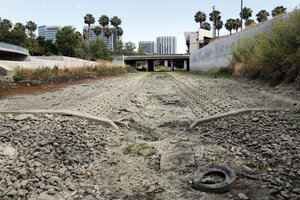A river runs dry in California, despite successful water rationing
Half of the Guadalupe River in San Jose is bone dry, and water managers are saying they're having to make 'hard choices' regarding how to use dwindling supplies.

Eight miles of the Guadalupe River have run dry in the drought. Here, the riverbed is shown near Santa Clara Street in San Jose, Calif.
Jim Gensheimer/San Jose Mercury News/AP
A river no longer runs through San Jose, thanks to the ongoing severe drought in California.
Eight miles of the 14-mile Guadalupe River, which runs through the city in Santa Clara County, Calif., is now bone-dry, filled with nothing but weeds, rocks, trash, and dead fish. Two years ago, the river was a thriving habitat for local wildlife, including ducks and beavers.
“A lot of the public have got used to seeing these systems running 365 days a year,” says Jerry Sparkman, a water resources supervisor with the Santa Clara Valley Water District. “So a lot of people are shocked to see these creeks dry and fish dying, but it’s part of a natural cycle… We just have to accommodate it.”
The river has been dry “for quite a while now,” says Marty Grimes, a spokesman for the water district. “We’ve been dealing with drybacks on that river and pretty much every creek in the county for about a year and a half.”
The district has said that they are reluctant to release a lot of water into the river because, with regional groundwater so low, the dry soil would soak it up and the water would be gone within a month. It often takes three to four days of steady rain for any run-off to build in county creeks and streams, according to Mr. Sparkman.
“We have to go through the numbers and figure out how much water we can release and have an idea of how much water we need to carry into the next year in case the rains don’t start until next year,” he adds.
The drying of the Guadelupe comes despite the county's recent successes with water conservation. In May and June the county surpassed its monthly target of 30 percent reductions in water usage, compared with 2013, according to the San Jose Mercury News.
But because most water for residential and business use in the county is imported, personal water frugality does not equate to flowing rivers, Sparkman says. With the creeks and rivers supplied by dwindling dam reserves, water managers say they have to balance keeping streams flowing with completely emptying their sources.
The county relies on four reservoirs to supply the Guadalupe River, and all the dams in the county are supplied by rainwater run-off. Still, over half the county’s water is imported from other sources – principally other reservoirs in the state supplied by snowmelt from the Sierra Nevada mountains more than 200 miles from the city.
Jae Abel, a biologist with the water district, says that with all water sources depleted by the four-year drought, they’re having to make “hard choices as to which parts of the system [we] keep operable.”
“All of our sources are running very, very shy in the drought,” he adds.
For Mr. Abel, the conditions are the most extreme he’s seen since California’s 1976 to '77 drought. The only difference now, he says, is that the population is higher, so both demand and public expectations are higher.
“We’re trying to do what we can with what we have,” says Abel. “It’s kind of an education for everybody.”

